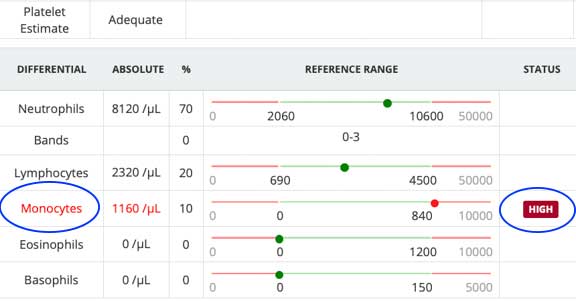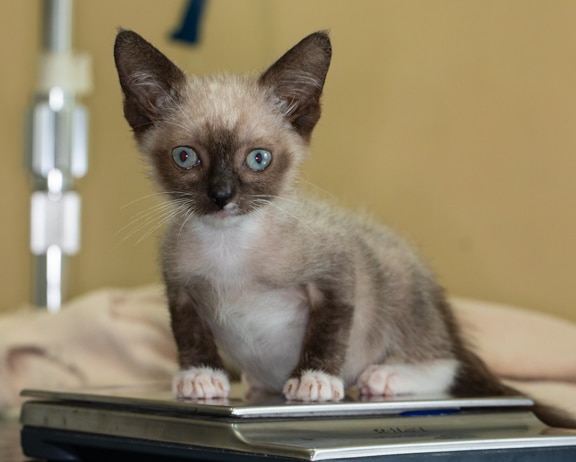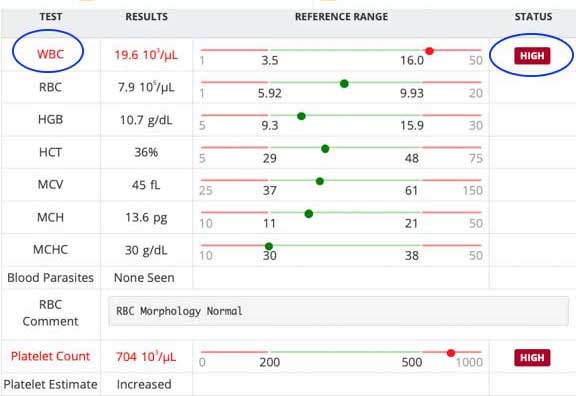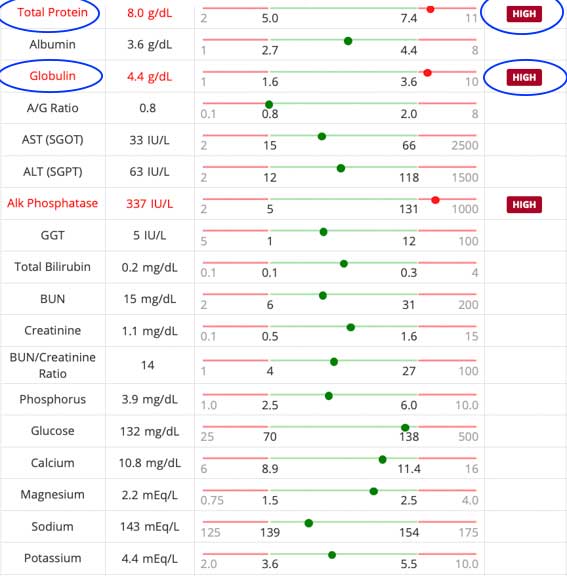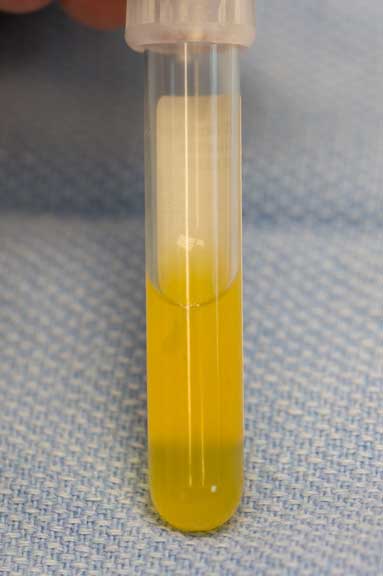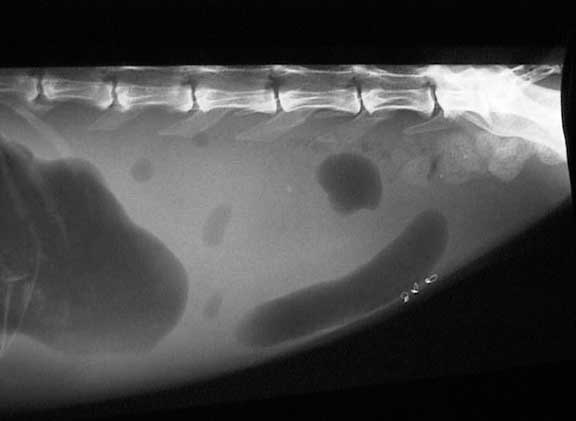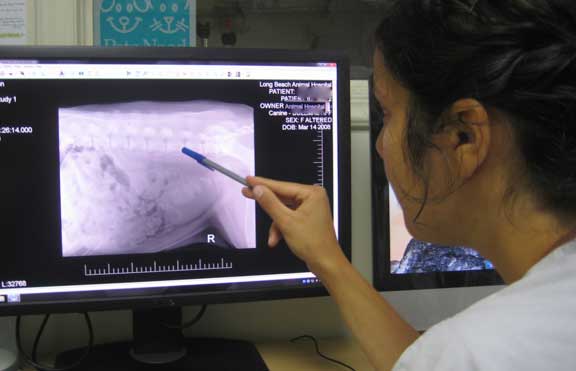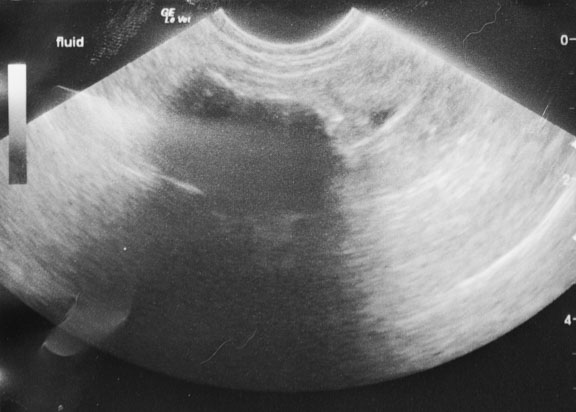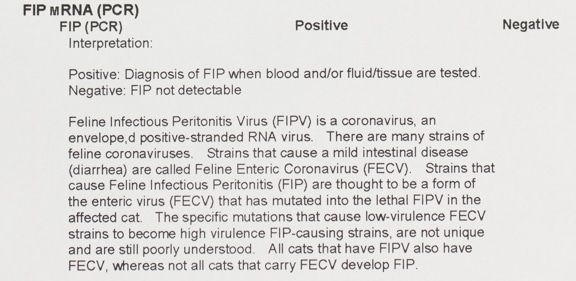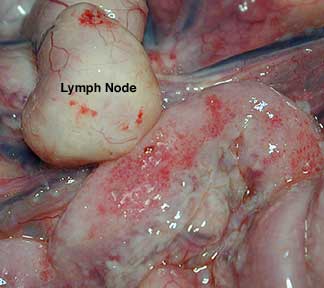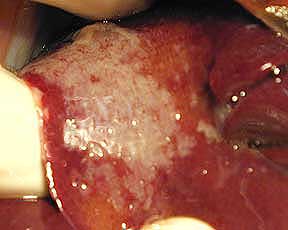As veterinarians we have been dealing with the cat version of Corona Virus for many decades. This gives us a unique perspective on diagnosing and treating this problem.
FIP, one of the most mysterious diseases a wild or domestic cat can fall victim to, was recognized in the late 1950’s. It is the cause of death in anywhere from 0.3% – 1% of cats. This makes it one of the leading infectious causes of of death among young cats, especially from shelters and catteries.
It can occur at any age, although it is seen more often in cats 3-16 months years of age, and is uncommon after 5 years of age. Multiple cat households, along with cats that spend time outdoors, are most susceptible. Stress is implicated as a factor in pre-disposing a cat to allow the FIP virus that is being contained to become pathogenic and cause the disease. This is another reason to enrich your cat’s environment.
Cheetahs are particularly susceptible to this disease because of their lack of genetic diversity.
Dr. P took this low res photo of a cheetah in the Serengeti. To see many more photos at a higher resolution please follow the Wildlife Photography page link.
Dr. P recently spent time at the Cheetah Conservation Fund in Namibia started by Dr. Laurie Marker. They have decades worth of genetic information on cheetahs, and do genetics research constantly. Click here to learn more about this on his trip to Namibia.
FIP has also been seen in African lions and Mountain lions, Leopards, Jaguars, Servals, and Caracals.
The virus that causes this disease is spread by respiratory secretions and feces. Litter that is contaminated with the virus is easily trapped on a cat’s fur, which is ultimately swallowed when the cat grooms. Cats infected with FeLV also are more at risk of developing this disease. A cat with a case of FIP is not contagious to other cats.
FIP has the subject of considerable controversy over the decades regarding diagnosis and treatment. This is partially due to the environmental situation that cats are placed in that causes undue stress on their immune systems, along with the complicated and variable immune response they develop when potentially faced with this virus.
Like many cat diseases, FIP mimics other cat diseases, so a diagnosis in many cases does not come easily, especially in what is called the “dry” form.
Neils Pederson of the UC Davis veterinary school is the most knowledgeable person in veterinary medicine regarding this disease. He has been studying it since 1964, trying to find a treatment for it, and developing a vaccine to prevent it. He has made major progress recently that you will learn about in this page. Further information is on his web site- sockfip.org
You can also learn more about black market drugs for FIP from the AVMA (American Veterinary Medical Association) web site.
This page contains graphic photos of a necropsy (autopsy) towards the end of the page.
Cause
FIP is caused by a coronavirus, that has mutated from a harmless intestinal virus of cats called the feline enteric coronavirus (FECV). It is not known why the virus mutates from the harmless FECV (it can cause a mild intestinal upset) to the pathogenic FIP.
It is not a part of the COVID-19 virus (SARS-CoV-2, also called the novel coronavirus), and it does not spread from cats to people, so don’t sanitize your cat with chlorox just yet!
The mutation is complicated (is anything in medicine, or in cats for that matter, not complicated?). It has to do with spike (S) proteins, a truncated 3c gene and tropism. Add in cell-mediated immunity, partial cell-mediated immunity, and humoral immunity to the mix, and you get a feel of the complexity of why some FEVC mutate to the pathogenic FIP and some do not.
Risk factors for this disease are multiple cat households, the presence of normal cats that shed coronavirus, age, immune status, and the development of FIP susceptible cats (including certain breeds and bloodlines) in the general cat population. The continual infection and reinfection of cats with coronavirus in multiple cat households increases the chance of an individual cat developing FIP.
Any cat infected with a corona virus has the potential of developing FIP, in fact recent studies suggest up to 10% of cats infected with the corona virus may develop FIP. To give you some perspective on the current situation, up to 50% of household cats, and up to 90% of cattery cats, carry the coronavirus.
Multiple cat households might be more susceptible due to increased stress, crowding, poor sanitation, parasites, and other diseases like the FeLV and the FIV. Cats can spread the coronavirus in their nasal and oral secretions, along with the feces.
Purebred cats have a greater predisposition to this disease than mixed breed cats.
Even though the virus can remain infective in the environment (contaminated feeding utensils, etc.), it is easily destroyed by routine disinfectants. This virus poses no health risk for people.
Pathogenesis
Within 24 hours of ingestion the virus spreads from the tonsils to the intestines. The regular coronavirus stays in the intestines and only causes mild disease like diarrhea. When the virus leaves the intestines is when the potential for FIP starts.
A virulent form of this virus that leaves the bloodstream can go to white blood cells called monocytes. These monocytes infected with this virulent strain of corona virus enters other organs and spread the disease, and now we have FIP.
Monocytes are measured on every CBC we perform. When elevated like this at 1160 (up to 840 is normal for this lab) it is called monocytosis.
Within 2 weeks it has spread to the large intestine, intestinal lymph nodes, and the liver. From there it can spread to any other body organ. Cats that do not produce a full antibody response to the virus will end up with fluid buildup within body cavities, usually the chest or abdomen. In the chest it is called pleural effusion, in the abdomen this fluid is called ascites.
Cats that develop a full immune response to the virus do not get this disease, although they can harbor a latent version of the virus for a period of time. They are immune, but carry the pathogenic version of the coronavirus. If they become immunocompromised for some reason (stress, drugs, crowding, parasites, other disease like kidney disease or diabetes) their infection can be reactivated.
This disease has two major manifestations. The first is called the “dry form”. In the dry form the white blood cells are involved, and cause an inflammatory reaction to the internal organs. These organs do not function normally because of this inflammation, and eventually will fail as the disease progresses.
The dry form of FIP develops as a result of only a partial immune response to the mutated virus. The wet form of FIP develops as a result of a failed immune response to the mutated virus.
The other manifestation of this disease is called the “wet form”, which is where the original name of “peritonitis” (inflammation of the lining of the abdominal cavity) came from. It is called this because fluid accumulates in the abdomen or the chest. The fluid that appears in the wet form is straw colored to yellow in appearance, and has a relatively high protein content. The wet form is more common than the dry form.
The fluid originates from small blood vessels that have been affected by the immune systems response to the virus. This immune response damages these blood vessels, causing them to leak fluid into the abdominal cavity usually, or thoracic cavity less often.
FIP and FeLv were closely associated in the past. A cat with FeLV was more susceptible to getting FIP. Many of the cats that had FIP were FeLV positive. With the advent of the highly effective FeLV vaccine that is no longer the case.
It has been found that Persian, Abyssinian, Himalayan, Bengal, Rex, Ragdoll, and Birman cats may have an increased susceptibility to the FIP virus.
Symptoms
Initially there are no or minimal symptoms after exposure. Symptoms might not appear for weeks, months, and even years, after the initial infection. So much of it depends on the immune system.
A waxing and waning fever, sometimes called a fever of unknown origin (FUO), is one indication a cat might have FIP.
Some cats might show mild upper respiratory signs (sneezing) or diarrhea, but are so mild that they can go unnoticed. When serious symptoms do appear, the signs might be sudden in the younger cats, or more gradual in older cats.
Cats that have dry form have vague symptoms that come and go, and can affect many different systems in the body. They might be lethargic, have poor appetites, weight loss and look ill.
Common organs involved are the eyes, central nervous system (brain and spinal cord), and internal organs like the liver and kidney. Other symptoms could include growth retardation, anorexia, poor hair coat, weight loss, seizures, paralysis, behavior changes, poor vision, increased sensitivity to touch, and urinary incontinence. Another clue to dry FIP is a cat with an ongoing fever. It might wax and wane, and usually does not respond to antibiotics.
This is typical of the neurologic signs that can occur with this disease
Since many different organs can be involved with the dry form, the symptoms we see with this form of FIP can mimic other common diseases of cats, like hyperthyroidism, liver disease, sugar diabetes and kidney disease.
Other diseases like inflammatory bowel disease, cancer, and toxoplasmosis might also have similar symptoms. Pets with the wet form of the disease may have breathing difficulty or distended abdomens, in addition to some of the symptoms of the “dry form”. The onset of these symptoms is faster than the gradual symptoms noted in the dry form.
The wet form of FIP is much easier to diagnose than the dry form. The virus can also infect the brain or spinal cord. This form of the disease can sometimes be diagnosed by an eye exam. Changes can be noted in the back of the eye, especially the retina.
A distended abdomen that is filled with fluid is the classic sign of a cat with wet FIP. There are other causes to abdominal fluid buildup in a cat though, so a diagnosis cannot be made just on this symptom.
Several risk factors seem to predispose some cats to getting FIP:
- Ongoing infections
- Early Weaning
- Overcrowding
- Age at time of infection
- Genetic predisposition
- Stressful environment at the time of exposure
Diagnosis
Diagnosis is difficult in many cases, particularly in the dry form. We do not have a blood test that tells us if the virus is present like we have with FeLV and FIV. The tests we do have tells us if antibodies have been made to the category of virus that FIP belongs to (coronavirus), but it does not tell us if it is the actual FIP virus or not.
There are DNA type tests available that are more specific in making this diagnosis, the most common one being the polymerase chain reaction (PCR) test. The PCR test detects mitochondrial DNA of the M gene of all known feline coronarvirus strains. It has to detect this in the monocytes for the disease to be FIP.
As we generate more data on this test in sick cats its usefulness will probably increase. In addition to specific FIP antibody or DNA tests, blood samples, X-rays and fluid analyses are also used, and are utilized especially in cats that have the wet form. The only way to be 100% certain of the diagnosis is to biopsy one of the abdominal lymph nodes, the kidneys, or the liver.
Physical Exam
Cats that have FIP will have physical exam findings similar to other feline diseases. In the wet form the fluid buildup in the abdomen or chest becomes apparent as time goes on. One of the ways we check for fluid within the abdomen during an exam is to look for a fluid wave by tapping on the abdomen. These cats will often have a persistently waxing and waning fever as well.
Blood Panel
The white blood cells (WBC) might be low, normal or high, depending on how long the problem has been present and if other problems also exist. The red blood cell count might be normal or low (anemia).
This WBC count of 19,600 (up to 16,000 is normal for this lab) is not unusual in cats with FIP.
The biochemistry profile commonly reveals an increase in total protein and globulins. This increase is from the inflammatory process occurring as the body responds to the virus. This increase in globulins, called hyperglobulinemia, occurs more often in the dry form.
This blood panel shows an increase of Total Protein and Globulin (hyperglobulinemia) in an FIP positive cat
Other tests on the biochemistry profile could indicate FIP, but not necessarily, since these problems could occur with other diseases also. As a case in point, if the kidney values are increased in an older cat with suspicion of FIP, some of the possibilities are:
- Chronic renal failure along with FIP (this cat has 2 different diseases)
- Chronic renal failure with no FIP
- FIP causing kidney disease
- Dehydration due to FIP
- Dehydration due to disease in some other organ
Fluid Analysis
The fluid that builds up in the wet form of FIP is called ascites when it occurs in the abdomen, and pleural effusion when it occurs in the thorax. The fluid is sticky and usually light yellow to golden color (straw colored), with a relatively large amount of protein.
This is what the fluid looks like just after is has been removed from the body
The report from the clinical pathologist on fluid that his highly suspicious of FIP
Radiography
The following x-rays are of a normal cat first, and then one with the wet form of FIP. Approximately 100 ml (3 ounces) of fluid was removed from the chest of the cat with the fluid. After the fluid was removed it was analyzed because other diseases can cause fluid in the thorax (pleural effusion) also.
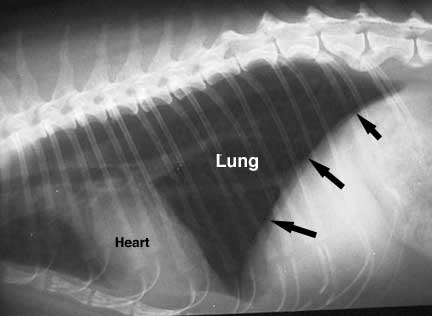
This is an x-ray of a normal cats thorax. This cat is laying on its right side, the head is towards the left. You can see the heart and the black lung tissue in the shape of a triangle. The diaphragm (arrows) is the vertical line that separates the thorax on the left from from the abdomen on the right. The liver resides in the abdomen.
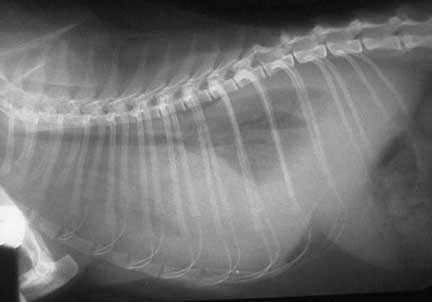
This cat has a significant amount of fluid in the thorax (pleural effusion), making it difficult to identify normal organs. You cannot see the heart or diaphragm, and the lung tissue is greatly reduced because of all the fluid. The lungs are unable to expand fully causing significant difficulty in breathing. This pet is very ill and has minimal breathing reserve. It needs immediate removal of the fluid.
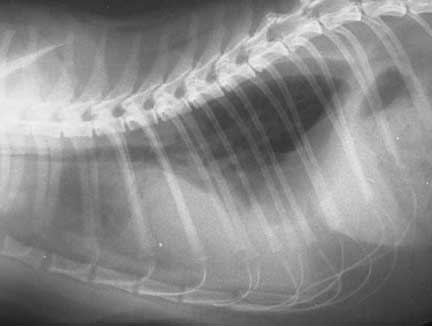
After some of the fluid was removed it is possible to visualize more of the organs. There is more lung tissue present and the top of the diaphragm is now visible.
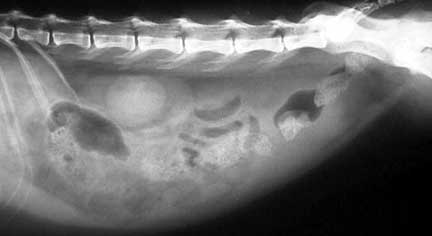
The fluid found in the wet form of FIP can also occur in the abdomen (ascites). In this radiograph, the evidence of fluid accumulation is subtle, but present.
The fluid build up in this cat’s abdomen is obvious. You cannot see any individual internal organs due to the fluid.
Learning how to read a radiograph is a hard fought medical skill. In many cases we utilize the help of our radiologist- Dr. Ann Reed. Click here to learn much more about reading radiographs in animals.
The students in our externship program spend time learning how to read a radiograph. We start them early down the path of the lifetime commitment needed to learn this skill. The fact that we take radiographs on a wide variety of species in addition to dogs and cats adds to the knowledge base they need to have.
Ultrasound
Ultrasound gives us additional information on the internal organs. It augments what we see radiographically, and is an important diagnostic modality in many animal diseases since they cannot talk to us and tell us where there is a problem. Our ultrasounds are performed by a radiologist, a specialist in performing ultrasounds.

The ultrasound gave us additional information we do not normally obtain from radiography. An enlarged mesenteric lymph node (see the lines marking it off), in a cat with other indications of FIP, does not verify the diagnosis, but makes it very likely.
Antibody Test
Our routine blood panel in cats can also include an FIP titer. This test is not used to diagnose FIP
This titer detects the presence of antibodies to the corona virus, indicating exposure to the virus at some time in the past. It does not tell us if this coronavirus is FECV (the nonpathogenic corona virus) or the FIP virus.
This cat might have FIP, but it might not. Also, some FIP vaccines can cause an elevated coronavirus titer. We need to see a relatively high titer, along with the routine symptoms of FIP, to make us think a cat with a high coronavirus titer indeed has FIP.
To further complicate the picture, cats presented to us in the final stages of FIP, where the symptoms can mimic many other diseases, might not have any titer due to their inability to mount any immune response, hence they do not produce antibodies detectable by this test..
DNA Test (PCR)
The DNA test for FIP is called the RT-PCR. It stands for reverse-transcriptase-polymerase chain reaction. It can be performed on blood, feces, fluid, and tissue. Not all cats with FIP have the virus in the bloodstream (called viremia), so a negative result with this test on the blood does not guarantee the cat does not have FIP. Also, the FECV (the nonpathogenic coronavirus) can sometimes be found in the bloodstream leading to a false positive.
To further complicate the problem, cats with the dry form of FIP, (the very cats we run this PCR test on since we are not sure it is FIP or some other common disease causing the problem), often do not have the FIP virus circulating in the bloodstream. In this case, there will be a false negative.
The test is very sensitive, so it will usually find the FIP if it is there. There is a tradeoff to this sensitivity though. It is so sensitive that if the lab does not practice a high level of quality control we might get a false positive. What this test does is look for viral nucleoprotein to the FIP virus. There is a version of this test, called the 7B protein test, which further tries to differentiate the nucleoprotein found in FIP from the nucleoprotein found in FECV.
This is a positive PCR test result
There is another test, called the Rivalta test, that can be performed. A positive test is consistent with FIP in kittens, but not as much in older cats due to diseases like cancer and sepsis causing a positive result.
Histopathology
In many FIP cases, especially the dry form, the only way to confirm the diagnosis is to biopsy an internal lymph node or internal organ, and look for specific microscopic changes that occur in FIP. This biopsy can be performed on a live cat during an exploratory surgery, or during a necropsy (the animal version of an autopsy) in a dead cat.
Common organs to biopsy are the liver and kidney. In addition, the mesenteric lymph node (remember the ultrasound above where it was enlarged?) is a good organ to biopsy.
This necropsy picture shows an enlarged mesenteric lymph node. Below it you can see the inflammation that has occurred on the outer surface of the intestines. This inflammation causes peritonitis (inflammation of the lining of the abdominal cavity). This is how the disease became to be known as Feline Infectious Peritonitis when it was originally discovered.
This autopsy picture shows a reaction on the surface of the liver. This reaction is called pyogranulomatous, and is the basis for the diagnosis.
This is the final report we received from the pathologist on the above tissue samples
Treatment
Over the years many different treatments have been attempted to alleviate symptoms of this disease. Some of them seem to work for variable periods of time, so they are worth trying in some cases. These include antibiotics, anti-inflammatories, immune system stimulators, and vitamins, along with a non-stressful environment and supplemental hydration if needed.
There has been no consistent treatment that will cure this disease, and cats with confirmed cases of FIP usually succumb within a few months or are euthanized due to their condition.
A medication called Polyprenyl Immunostimulant has shown potential experimentally for the dry form. It has been used to treat herpes virus. More work needs to be done to make sure it works and does not cause side effects. Work on this treatment is being done by Alfred M Legendre, DVM, of the University of Tennessee.
You can find these treatments in our section on FeLV, since both diseases are treating the symptoms of the virus and not the actual virus. The caveats in treating FeLV also apply to FIP.
Several antiviral medications have given new hope in treating FIP, and are the best hope for the future. They have shown good results, and are in the testing stage.
One of these drugs is a 3C-like protease inhibitor called GC-376 that has shown some promise. A company called Anivive Lifesciences is working on FDA approval for this drug.
Another drug, called GS-441524, is showing even more promise. It has been produced by Gilead Sciences, but it is not available for veterinary use. This is because it is the biologically active compound in the drug remdesivir (GS-441524) currently used to treat ill patients with COVID-19.
In the future they will probably the most effective way to treat wet FIP. Getting FDA approval for these drugs will take many more years and a large investment of money from some drug company.
Several Chinese companies make drugs like GS-441524 for sale on the black market to treat FIP. They are marketed as dietary supplements because they do not have FDA approval. Their us in veterinary medicine is illegal, so they tend to be purchase online and in user groups on Facebook.
The most well known one is Mutian, costing $4,000 for a 7 pound cat. There is some evidence it works, although much remains to be learned, so buyer beware if you try these drugs on your cat with FIP. There are potential sterility and toxicity issues, and there is no way to confirm that the bottle actually contains what it says it does.
This company touts the use of this drug to stop the shedding of feline corona virus by healthy cats. Dr. Pederson feels this is a greatly misguided approach, and that the company is putting profits over proper science.
Other drugs that show promise are an anti fungal called Itraconazole and an anti-feline tumor necrosis factor (TNF)- alpha monoclonal antibody. It remains to be seen if they will work out and are not toxic.
Since it is difficult to confirm the presence of this disease, especially in the dry form, it is worth the effort to treat your cat symptomatically. Unfortunately, the long term outcome is poor.
Prevention
A vaccine was developed years ago, but it proved ineffective. Much has been learned about this disease, and an effective vaccine is a possibility. This will be the best way to “treat” FIP. This is a corona virus, and the knowledge learned about the FIP vaccine is being used to make a vaccine for COVID-19.
Controlling the Spread
Cats living in households that already had a cat die of FIP have a less than 5 percent chance of developing FIP, mostly because they have already been exposed to the virus and fought it off. Siblings of cats that died of FIP have a greater chance of developing the problem due to genetic heritability for an increased susceptibility to the virus.
The most important factor in controlling FIP is limiting the number of cats in a house, preferably to less than 5. In addition, good nutrition, good veterinary care, and good sanitation, will go along way to preventing this problem. Wait at least one month and preferably up to three months, before introducing a new cat to house that had a cat die of FIP.
Cleaning the litter pan often and preventing litter from tracking throughout the house may be helpful. The virus can live in the environment for several weeks, so clean as thoroughly as possible using a 1:32 dilution of household bleach. Remove all cat related products that cannot be thoroughly cleaned, and wait for 2 months before introducing a new cat into the household.
Dr. Pederson has a web site called sockfip.org that has more information.




